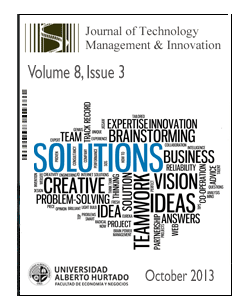Secreto Industrial y Cooperación Público-privada en I+D en el Sector Biofarmacéutico Argentino
DOI:
https://doi.org/10.4067/S0718-27242013000400012Keywords:
innovación, cooperación en I D, secreto industrial, apropiación, biofarmacéuticoAbstract
The article presents a study on the use of secrecy in Argentine biopharmaceutical firms that innovate through public-private cooperation. When innovation is achieved by cooperating with public and external sources of knowledge, the company is exposed to higher risks that critical knowledge leaks out to potential competitors, undermining the effectiveness of secrecy. To investigate this issue, study cases have been conducted on firms whose innovation projects are carried out by cooperating with public R&D institutions. The results suggest that the specific features of cooperation determine different possibilities for firms to face those risks, adapt its strategy of appropriation and protect the generated knowledge.Downloads
References
ARROW, K. (1962) Economic Welfare and the Allocation of Resources for Invention. En: R. NELSON (ed.), The Rate and Direction of Inventive Activity. Princeton University Press, Princeton (NJ). pp. 609–625.
ARUNDEL, A. (2001). The Relative Effectiveness of Patents and Secrecy for Appropriation. Research Policy, 30(4), 611-624.
BERCOVITZ, J. y FELDMAN, M. (2007). Fishing upstream: Firm innovation strategy and university research alliances. Research Policy, 36(7), 930-948.
BROUWER, E. y KLEINKNECHT, A. (1999). Innovative output and a firm’s propensity to patent. An exploration of CIS micro data. Research Policy, 28(6), 615–624.
COHEN, W.M.; NELSON, R.R. y WALSH, J.P. (2000). Protecting Their Intellectual Assets: Appropriability Conditions and Why Us Manufacturing Firms Patent (or Not). National Bureau of Economic Research, Cambridge (MA).
CORIAT, B., ORSI, F. y WEINSTEIN, O. (2003). Science- Based Technological Regimes and Institutions: Does Biotech Reflect a New Science Based Regime? Industry and Innovation 10(3), 231-253.
CORREA, C.M. (1990). Patentes, industria farmacéutica y biotecnología. Revista del Derecho Industrial, 12, 335-343.
DÍAZ, A.; KRIMER, A. y MEDINA, D. (2006) Salud Humana: de la industria farmacéutica a los biofármacos. En: BISANG, R.; GUTMAN, G.; LAVARELLO, P.; SZTULWARK, S. y DÍAZ, A. (Comp.). Biotecnología y desarrollo. Un modelo para armar en la Argentina. Prometeo Libros, Buenos Aires. pp.103-138.
EISENHARDT, K. M. (1989). Building Theories from Case Study Research. Academy of Management Review, 14(4), 532-550.
FERNÁNDEZ SÁNCHEZ, E.; MONTES PEÓN, J.M.; PÉREZ BUSTAMANTE, G. y VÁZQUEZ ORDÁS, C.J. (1998). Acumulación, Naturaleza e Imitación del Conocimiento Tecnológico: una Revisión de la Literatura. Investigaciones Europeas de Dirección y Economía de la Empresa, 4(1), 11-34.
FERNÁNDEZ SÁNCHEZ, E. (2004). Formas de apropiación de las ganancias de una innovación. Universia Business Review, 1, 70-81.
GALENDE DEL CANTO, J. (2006). La apropiación de los resultados de la actividad innovadora. Manuscrito no publicado, Universidad de Salamanca.
GONZÁLEZ, N. y NIETO, M. (2007). Appropriability of innovation results: An empirical study in Spanish manufacturing firms. Technovation, 27(5), 280-295.
GRILICHES, Z. (1990). Patent Statistics as Economic Indicators: A Survey. Journal of Economic Literature, 28(4), 1661-1707.
GUTMAN, G. y LAVARELLO, P. (2010). Desarrollo reciente de la moderna biotecnología en el sector de salud humana. Documento del Proyecto CEUR-CONICET “Potencialidades de la biotecnología para el desarrollo industrial de Argentina”, Buenos Aires.
HARABI, N. (1995). Appropriability of technical innovations: An empirical analysis. Research Policy, 24(6), 981-992.
HURMELINNA-LAUKKANEN, P. y PUUMALAINEN, K. (2007). Nature and Dynamics of Appropriability: Strategies for Appropriating Returns on Innovation. R&D Management, 37(2), 95-112.
HUSSINGER, K. (2006). Is Silence Golden? Patents versus Secrecy at the Firm Level. Economics of Innovation and New Technology 15(8), 735-752.
LEVIN, R.C.; KLEVORICK, A.K.; NELSON, R.R.; WINTER, S.G.; GILBERT, R. y GRILICHES, Z. (1987). Appropriating the Returns from Industrial Research and Development. Brookings papers on economic activity, 18(3), 783-831.
MANSFIELD, E. (1986). Patents and Innovation: an empirical study. Management Science, 32(2), 173-181.
MARCH, J. (1991). Exploration and exploitation in organizational learning. Organization Science, 2(1), 71-87.
MILESI, D.; VERRE, V.; PETELSKI, N. y AGGIO, C. (2011). Apropiación privada de las rentas de la innovación: elementos para la discusión conceptual y el abordaje metodológico. Manuscrito no publicado, Universidad Nacional de General Sarmiento.
MILESI, D., PETELSKI, N., VERRE, V., (2013). Innovation and appropriation mechanisms: Evidence from Argentine microdata. Technovation, 33(2-3), 78-87.
SCHUMPETER, J.A. (1942). Capitalism Socialism and Democracy. Harper and Row, New York.
TEECE, D.J. (1986). Profiting from Technological Innovation: Implications for Integration, Collaboration, Licensing and Public Policy. Research policy, 15(6), 285-305.
YIN, R. (1981a), The case study as a serious research strategy. Knowledge: Creation, Diffusion, Utilization, 3, 97-114.
YIN, R. (1981b). The case study crisis: Some answers. Administrative Science Quarterly, 26, 58-65.
YIN, R. (2003). Case study research: design and methods. Third edition: Applied Social Research Methods Series, Vol. 5. SAGE Publications, Thousand Oaks, CA.
Downloads
Published
How to Cite
Issue
Section
License
Copyright (c) 2013 Journal of Technology Management & Innovation

This work is licensed under a Creative Commons Attribution-ShareAlike 4.0 International License.







